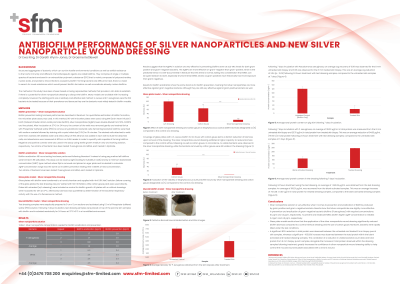Laboratory Research
(LR-027) Antibiofilm performance of silver nanoparticles and new silver nanoparticle wound dressing
Friday, April 28, 2023
7:15 PM - 8:30 PM East Coast USA Time

Graeme Kettlewell, PhD – Director of Research and Development, R&D, Speciality Fibres and Materials Ltd; Gareth Wynn-Jones, PhD – R&D Manager, R&D
Introduction: Structured aggregates of bacteria, which can survive hostile environmental conditions as well as exhibit resistance to the host’s immunity and different chemotherapeutic agents are called biofilms. They comprise of single or multiple species of bacteria enclosed in an extracellular polymeric substance (EPS) that is mainly composed of polysaccharides, nucleic acids, and proteins. Since infections caused by biofilm-forming bacteria are difficult to treat, there is a need to search for novel substances which would prevent biofilm formation as well as eradicate already mature biofilms.
Methods: Silver nanoparticle testing has been divided into two parts: biofilm prevention and biofilm eradication. In both tests two strains of bacteria has been used: P.aeruginosa and MRSA. During biofilm prevention study 96 microtiter plates were used, with BHI broth and were incubated for 24 hours. Detection of cells capable of forming biofilms has been assessed with ELISA reader. Biofilm eradication has been conducted in 96-well plates and incubated for 48 hours. Detection has been carried out by calculation of bacteria on agar plate.
Testing on silver nanoparticle cellulose dressings have been conducted using two different models: glass plate model using S. aureus biofilm and mucoid P. aeruginosa biofilm grown on porcine explant skin. In both cases dressing has been applied for 24 hours.
Results: Results suggest that silver nanoparticles in solution are very effective in fighting biofilms even at sub-MIC levels for both gram-positive (1.4 ppm for eradication and 0.1 ppm for prevention) and gram-negative bacteria (4.6 ppm for eradication and 3.4 ppm for prevention). Additionally, both dressing models showed excellent activity of silver nanoparticle cellulose dressing. Glass plate model showed a S.aureus biofilm reduction by 94%, whereas mucoid model showed over 3 log reduction in viable bacterial count of P.aeruginosa.
Discussion: Silver nanoparticles are more effective on gram-negative than gram-positive bacteria, which is the predicted trend. The activity of the dressing demonstrates that the biofilm is absorbed into the dressing where the silver present has an antimicrobial effect against the biofilm.
Methods: Silver nanoparticle testing has been divided into two parts: biofilm prevention and biofilm eradication. In both tests two strains of bacteria has been used: P.aeruginosa and MRSA. During biofilm prevention study 96 microtiter plates were used, with BHI broth and were incubated for 24 hours. Detection of cells capable of forming biofilms has been assessed with ELISA reader. Biofilm eradication has been conducted in 96-well plates and incubated for 48 hours. Detection has been carried out by calculation of bacteria on agar plate.
Testing on silver nanoparticle cellulose dressings have been conducted using two different models: glass plate model using S. aureus biofilm and mucoid P. aeruginosa biofilm grown on porcine explant skin. In both cases dressing has been applied for 24 hours.
Results: Results suggest that silver nanoparticles in solution are very effective in fighting biofilms even at sub-MIC levels for both gram-positive (1.4 ppm for eradication and 0.1 ppm for prevention) and gram-negative bacteria (4.6 ppm for eradication and 3.4 ppm for prevention). Additionally, both dressing models showed excellent activity of silver nanoparticle cellulose dressing. Glass plate model showed a S.aureus biofilm reduction by 94%, whereas mucoid model showed over 3 log reduction in viable bacterial count of P.aeruginosa.
Discussion: Silver nanoparticles are more effective on gram-negative than gram-positive bacteria, which is the predicted trend. The activity of the dressing demonstrates that the biofilm is absorbed into the dressing where the silver present has an antimicrobial effect against the biofilm.

.png)